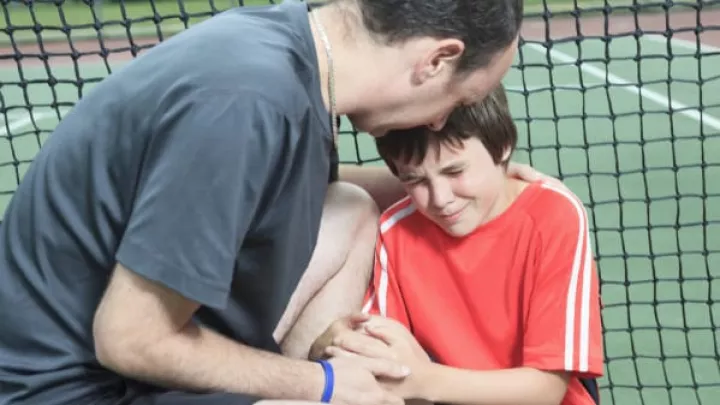
Four Things You Should Know Before Your Young Athlete Returns to Sports
Playing sports has plenty of physical and mental benefits: It can improve health, boost your mood, offload stress, reduce anxiety and build confidence. But for months, children and teens have been missing out on organized sports due to COVID-19. When recreational and league sports restart—with the appropriate precautions in place—young athletes will have a chance to head out and become active again.
Before rushing back on the field, it’s vital to know how to make that transition and to remain strong and healthy.
“I understand the excitement about returning to sports, but sometimes kids can get too excited and rev up too soon,” says Bianca Edison, MD, MS, an Attending Physician in the Children’s Orthopaedic Center who specializes in sports medicine. “We’ve been seeing a sudden rush of injuries happening because a gradual return wasn’t pursued.”
Injuries can occur whenever an athlete has been away for a while. So whether your child has been sidelined because of the pandemic or a previous injury, here are a few tips for safely getting back in the game.
Ease into it
For young athletes who perform or compete at a high level, it’s imperative to first focus on re-establishing a foundation of basic fitness and conditional stamina before ramping up. “This should take at least six to eight weeks with a slow, steady re-integration back into an athlete’s previous training level,” advises Dr. Edison.

Even though children may feel healthy, during periods of inactivity the body undergoes physiological changes called deconditioning that can cause muscles to weaken and can affect overall stamina. If an athlete hasn’t been training regularly since the pandemic began, the muscle memory that previously was built up—which protects the joints and helps prevent injury—goes away.
“That’s why it’s so important to not suddenly go from zero to 100,” says Dr. Edison. “Without the adequate re-building of muscles, you could put too much stress on a certain part of the body. For example, we’ve seen a large number of baseball players who lost a lot of strength underneath their shoulder blades and in the core while they weren’t playing. Then they get back on the mound and throw too hard and tear their UCL [ulnar collateral ligament]. A gradual process is a must.”
An athlete’s biomechanical foundation and strength are fundamental to prevent injury. Working together with the Sports Medicine team in the John C. Wilson Jr. Motion and Sports Analysis Laboratory at CHLA can help identify any areas that need to be optimized before returning to pre-COVID competitive levels.
Additionally, kids or teens who were diagnosed with COVID-19 should be evaluated by their primary care physician, sports medicine physicians and cardiologists before returning to any form of athletics. This ensures their physical health, and especially their cardiovascular and respiratory systems, can withstand the stresses of high athletic play after having COVID-19.
Prioritize proper nutrition and hydration
Although training and conditioning are imperative, athletes must also pay attention to what they eat and how much water they drink. “We have to treat the athlete holistically. It’s not just bones and muscles; we have to be mindful about fueling ourselves properly to make sure the brain is in good shape to support the rest of the body,” says Dr. Edison.
Part of taking care of the brain is drinking plenty of water. Dr. Edison points to a 2018 research study conducted by exercise physiologists at the Georgia Institute of Technology that showed dehydration alters brain shape and cognition. For young athletes, that translates into an increased risk of injury.
“It only takes a bit of dehydration for your reaction time to start declining. If that’s slowed down, you’re not as agile and you’re not seeing that ball coming toward you,” says Dr. Edison.
Sleep, sleep, sleep
Similarly, sleep plays a huge role in brain function. It’s when the body rejuvenates and reboots, which in turn helps with focus and concentration.
“I tell my patient families that sleep is the No. 1—and actually the only—supplement that I will recommend,” says Dr. Edison. “When we do physicals and talk to patients about what they can do to become better athletes, it’s not protein powder, it’s not weightlifting, but sleep.”
According to the American Academy of Sleep Medicine, nine to 12 hours of sleep is recommended for children 6 to 12 years old, while teenagers should strive for eight to 10 hours. Dr. Edison advises against playing “catch up” on the weekend if you don’t get enough sleep during the week since the body functions best when it’s on a routine.
Moreover, screen time before bedtime should be limited. “Our bodies rely on a certain release of hormones, particularly cortisol, to get into proper sleep mode. If that cycle is disrupted, then the body doesn’t know when to release it and we don’t get good quality sleep,” explains Dr. Edison.
Check in routinely
Coaches, athletic trainers and parents should encourage young athletes to check in with their bodies to make sure nothing is hurting, and that they’re not pushing through pain. From a mental standpoint, it’s also beneficial to regularly ask children and teens how they feel as they get back onto the field, if they are ready to go to the next level of preparation or training, or if they need to hang out where they are.
“Any sort of mental hesitation can also cause a setback or increase an athlete’s risk of injury,” says Dr. Edison. “Even though kids can be really excited to get back to how they were playing before, we have to honor, not rush, the process so that they can perform well.”


